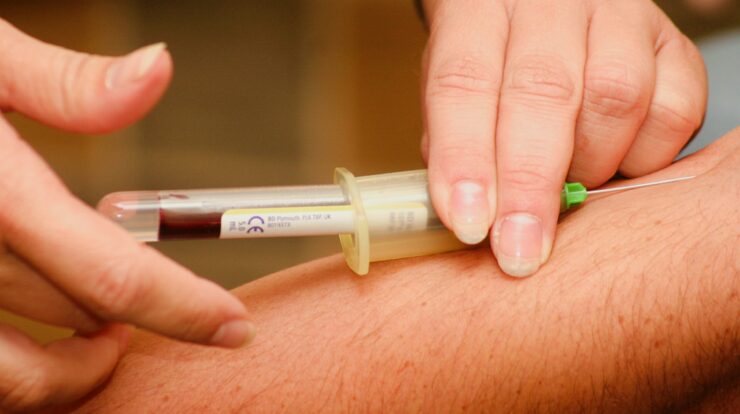
Blood tests are one of the best ways that medical professionals can identify ongoing health conditions. The test results can help doctors diagnose the cause of any symptoms that you may have, as well as highlight issues even if you aren’t outwardly displaying symptoms.
What is an RDW blood test?
A red blood cell distribution width test is a type of blood analysis that measures the red blood cells in your body, including their size and volume. Red blood cells carry the oxygen from your lungs around your body, which is why an anomaly with the cells can indicate serious problems.
An average red blood cell has a diameter of between 6 to 8 micrometers (µm). A big range in the size of your red blood cells results in a high RDW, whether the cells are too large or too small.
For example, if you have small red blood cells in addition to exceedingly small red blood cells, you will have a large RDW. This is also the case if you have multiple large red blood cells, as well as a collection of much larger red blood cells.
Why do I need an RDW test?
An RDW test is often offered as part of a routine blood examination at Urgent Care facilities or medical practices if you are exhibiting symptoms of conditions such as iron deficiency anemia, or you have a family history of blood conditions like sickle cell anemia or diabetes.
There are many medical reasons for a high RDW, as it is usually an indicator of an ongoing condition. However, not all medical conditions result in a high RDW. RDW cannot be used as the sole parameter in regards to complete blood count (CBC) analysis. It must be used as added context to other blood work as there are various factors that could have resulted in the high RDW.
The RDW test will be part of a comprehensive CBC test, which will examine the number of platelets, white blood cells and red blood cells that you have in your body. Any anomalies in these results can help your doctor to diagnose a number of medical issues that you may have such as:
- Iron or vitamin deficiency
- Chronic illnesses such as Crohn’s disease or HIV
- Infections
- Excessive blood loss (from surgery or injury)
How can I prepare for an RDW test?
Your doctor may ask you to fast in the lead-up to the CBC, depending on the type of blood tests that they will be conducting. This may help to highlight any vitamin or iron deficiencies you may have, without the interference of recent food that you have consumed.
The fast is usually required to last at least eight to ten hours before your blood test, although your doctor will be able to give you more information and guidance.
It’s also a good idea to notify your doctor of any medication that you are taking prior to your test, as they will be able to advise you on whether you are still okay to take it. However, it’s acceptable to continue taking most medication before your test as it won’t interfere with the process or results.
What happens during an RDW test?
An RDW test shouldn’t take longer than five minutes to complete. A medical professional will take a blood sample from a vein in your arm and store it in tubes. Once the required number of tubes has been filled (which is sometimes just a single tube), the needle will be removed and a small bandage will be placed over the entry site of the needle.
The needle may sting slightly, but it should be relatively painless. You should notify your healthcare professional if the wound bleeds continuously for several hours after the test. The blood in the tubes will be sent off to the lab for testing, after which you should be notified of the results in the following weeks.
What can RDW test results show?
An RDW test will show whether you have a significant variation in red blood cell volume or size. A normal RDW range in adult females is 12.2% to 16.1%, whilst adult males should have a range of between 11.8% to 14.5%.
Elevated RDW that are outside of this range can be an indicator that you may be suffering from a medical condition. However, to get a better idea of what these results could mean, the doctor will conduct other blood tests such as a mean corpuscular volume (MCV) test as part of a CBC. This will help to give a better picture of what could be causing the elevated red blood cell distribution issue and therefore the treatment that should be offered.
Medical conditions such as macrocytic anemia occur when your body isn’t producing the correct volume or size of normal red blood cells. This usually occurs when you have a low volume of folate or vitamin B-12.
However, even if you have a normal RDW, low MCV results could indicate anemia which is a side effect of chronic diseases such as kidney disease. Normal RDW and high MCV could show that you have aplastic anemia that shows your bone marrow isn’t producing enough red blood cells.
FAQs
What treatment will I get for abnormal red blood count?
There are a variety of treatment options if you have unusual red blood cell distribution width because there are different possible causes. For example, the treatment for anemia that is caused by low RBC could include the following:
- Iron supplements – for iron deficiency
- Vitamin supplements – for vitamin deficiency
- Blood transfusion – for blood loss
Chronic conditions such as kidney failure will also require special treatment, as will bone marrow failure. Your doctor will prescribe the necessary medication that you will have to take in order to treat the condition and maintain a good RBC.
In the instance of a high RBC, you may have to have regular blood draws to remove blood from your body and lower your RBC. If this doesn’t work, you may be prescribed hydroxyurea, which is a type of chemotherapy drug.
How often should I have an RDW test?
The frequency of your CBC tests (and subsequently RDW tests) will depend on whether you have any ongoing medical conditions. In some instances, your doctor may advise that you have a CBC test alongside your annual wellbeing check-up.
However, this may vary depending on your age and general health, as well as your family medical history. If you have underlying health conditions, you may need more frequent tests that could take place quarterly or at other intervals that your doctor thinks are required throughout the year.
Summary
A red cell distribution width test is a key indicator of the size and volume of the red blood cells in your body. An elevated RDW means that there is a large difference between your smallest and largest red blood cells, which could indicate an ongoing medical condition.
An RDW test will be conducted alongside other blood tests in a complete blood count. It is important that these results are analyzed alongside your RDW test results because the combination can pinpoint the cause of the RBC anomaly and will help your doctor to prescribe the best treatment.




